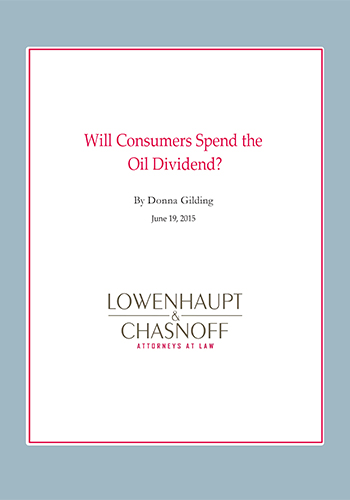Will Consumers Spend the Oil Dividend?
By Donna Gilding
In the latter half of last year, the price of crude oil dropped by over 50%. This was soon followed by a significant decline in the price of gasoline for motorists. It was assumed that this drop in price would have freed up money to spend elsewhere. The markets bet on this. The run-up in the US stocks last year reflected the belief that cheaper oil would act as a stimulus to the economy. This, in turn, would allow the Fed to increase rates, attract funds to the US, and push up the dollar.
The Best Laid Plans
The stock markets in 2014 did rally. The S&P 500 was up 13.69%. Consumer discretionary stocks, which represent non-essential consumer goods whose sales are primarily driven by the economic cycle, were up 8.43%. They are generally seen as a leading indicator – rising when the overall trend is up and heading down when the trend reverses. That said, it appears that investor confidence has remained muted and the oil dividend has not been spent. The latest University of Michigan consumer sentiment survey showed the sharpest drop in several years for US economic growth. Retail sales have also disappointed. J.P. Morgan reported that the 6.6 percent annualized growth rate for US retail sales growth for the fourth quarter 2014 has fallen to near zero in the first quarter of this year. Consumer discretionary companies’ annual revenue growth in the first quarter was also anemic at 1.1 percent.
Wall Street analysts still believe that the dividend will appear. They are projecting retail growth of 4.7 percent for the sector in the fourth quarter. In addition, the Fed needs to have some of the oil dividend come through if its relatively positive economic forecasts are to play out. The recent minutes of the Fed’s April meeting have made it clear that there will be no rate hike in June and “that the expected boost to household spending from lower energy prices had apparently not materialized”.
Uncertainties and the Consumer
Consumers are also aware that there has been a sharp decline in investment spending by the oil companies themselves. In addition, oil prices jumped in February making consumers even more apprehensive. A number of our managers have indicated that they believe that consumers have actually been paying down debt rather than increasing their debt by spending more. Without an indication that the price of gasoline will stabilize at a lower level and that wages will start to rise, the consumer could well be unlikely to spend the oil dividend.
Wishful Thinking?
We are being told that the US and UK labor markets are stabilizing. Capital Economics has pointed out that household debt is actually not as serious as it was because consumers have actually been paying down debt. And, international surveys of consumer confidence suggest “positivity”. As one manager said: “Let’s just wait and see”.
The Bottom Line
Assuming the oil dividend eventually shows up, the Fed would indeed start raising rates late this year or early next year. This would strengthen the dollar and test the stocks that have reached and retreated from record levels. It would help the Eurozone, which could use a weaker currency. As managers remind us, this cannot happen automatically. The US middle class needs to see wages on the rise. This is the real issue that is critical for an increase in consumer confidence.
Donna Gilding is an investment consultant with more than 30 years of institutional investment experience.

